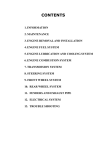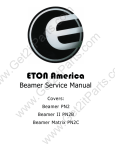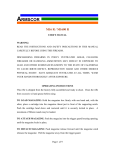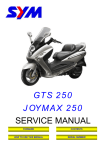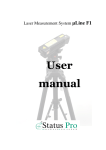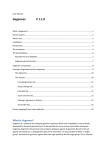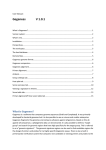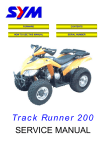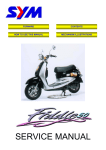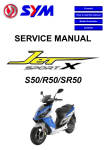Download Eton ATV8E - SERVICE Technical data
Transcript
11-5 Crankshaft Inspection Use a thickness gauge to measure left and right clearance of connecting rod big end. Service limit: 0.6 mm Measure point for the crank big end of the connecting rod. Measure the clearance of the big end at the vertical directions. Service limit: 0.05 mm Place the crankshaft on a V-block, measure run-out of the crankshaft. Service limit: 0.10 mm 90 mm 60 mm Check crankshaft bearing Use hand to crank the bearing to see it moves freely, smoothly and noiseless. Check the inner ring to see it links firmly on the bearing. If any roughness, noise and loose linkage are detected, replace the bearing with new one. Caution The bearing shall be replaced in pair. Special tool: outer bearing puller Check balance shaft bearing Crank bearing Check bearings on right and left crankcase. Rotate each bearings inner ring with fingers. Check if bearings can be turned in smooth and silent, and also check if bearing outer ring is mounted on gear tightly. If bearing rotation is uneven, noising, or loose bearing mounted, then replace it. Special tool: Inner bearing puller Bearing driver Balance shaft bearings 11-6 Assembly Of Crankcase Install wave washer into right crank bearing seat. Wave washer Install crank shaft on the right crankcase. Align the position mark on the balance shaft drive gear with that of balance shaft driven gear, and then install balance shaft onto right crankcase. Position mark Install 2 dowel pins and new gasket. Dowel pins Install the left crankcase onto the right crankcase. 11 bolts Tighten 11 bolts on the left crankcase. Torque value: 0.8~1.2kgf-m Tighten 2 bolts on the right crankcase. Torque value: 0.8~1.2kgf-m 2 bolts Clean the crankshaft. Apply a layer of grease on the lip of oil seal, Puts on the left crank shaft. Install the oil seal in the left crankcase with care not to damage the lip of the oil seal. By oil seal driver (27×42×7), oil seal will knock into located. Special tool: Oil seal driver (27×42×7) Oil seal driver Tensioner Install the tensioner and tighten the pivot bolt. Torque value: 0.8 ~1.2kgf-m Install the cam chain. Install the cam chain setting plate. Cam chain setting plate 12. COOLING SYSTEM 12-1 Mechanism Diagram 12-2 General Information 12-3 Trouble Diagnosis 12-4 Trouble Diagnosis For Cooling System 12-5 System Test 12-6 Radiator 12-7 Water Pump 12-8 Thermostat 12-1 Mechanism Diagram Radiator filler cap Reserve tank By-pass pipe To cylinder head Coolant outlet pipe Radiator Cooling fan Coolant inlet pipe Thermostat Thermo switch (fan) Water pump 12-2 General Information General Warning: While the engine is running, never attempt to open the radiator filler cap, the pressurized hot coolant may shoot out and cause serious scalding injury. No maintenance work is allowed to perform unless the engine is completely cooled down. y y y y y y Refill the radiator with distilled water or specified additives. Add coolant to the reservoir. The cooling system can be serviced on the ATV. Never spill the coolant to the painted surface. Test the cooling system for any leakage after the repair. Please refer to Section 17 for inspection of the temperature sensor switch for the fan motor and the water thermometer. Technical Specification Item Specification 0.9±0.15 kgf/cm2 850c.c. 420c.c. Begins to activate at 82~95к Stroke: 0.05~3mm Begins to activate at 98±3к Not-pressure: 107.7к Pressurized: 125.6к Pressure to open filler cap Capacity of coolant: Engine + radiator Reservoir upper Thermostat Thermos switch (fan) Boiling point Torque Value For water pump rotor 1.0~1.4kgf-m Tools Requirement Special tools Water pump bearing driver (6901): SYM-9100100 Water pump oil seal driver (Inner): SYM-9120500-H9A Water pump mechanical seal driver: SYM-1721700-H9A Inner bearing puller: SYM-6204020 12-3 Trouble Diagnosis The engine temperature is too high y The water thermometer and the temperature sensor do not work properly. y The thermostat is stuck to close. y Insufficient coolant. y The water hose and jacket are clogged. y Fan motor malfunction. y The filler cap of the radiator malfunction. The engine temperature is too low y The water thermometer and the temperature sensor malfunction. y The thermostat is stuck to open. Coolant is leaking y The water pump mechanical seal does not function properly. y The O ring is deteriorated. y The water hose is broken or aged. 12-4 Trouble Diagnosis For Cooling System The temperature indicated is too high Y A. Stop and waiting for the engine is completely cooled down, open cap to check the capacity of coolant in radiator. A1.Refill the radiator with coolant then check for any leakage? N Y Water leaking problem N Y B. Turn on main switch and check the water temperature indicator back to zero? N B-1. Measure thermo unit to confirm voltage 6VХ? N Replace thermo unit Y Y B-2. Inspect the circuits of water temperature have short or earth? Y Short or earth handle N Meter problem C. Open radiator cap and softly throttle, inspect coolant have circulated? C-1. Eng. stop and remove water pump cover, start the motor to inspect pump its rotation? N Y Y D. Close radiator cap, measure thermo unit to confirm voltage reduced comply with temperature rise? Y Next page Water pump repair N Water hose clogged N Replace thermo unit Preceding page E. Keep eng. 3000~4000 rpm and inspect cooling fan was operating after the temperature gauge over 3 checks? N E-1. Measure thermal switch to confirm voltage be changed (12Ш0V)? N Replace thermal switch Y Y F. Confirm the cooling fan was convulsion? E-2. Connect cooling fan terminals with battery (12V) directly to inspect its operation? N Replace cooling fan Y Meter unusual Y If circuit connects reverse cooling fan will forward, correct and check again. E-3. Keep eng. 3000~4000 rpm and inspect coolant flow into reserve tank after the temperature gauge over 3 checks? Y E-4. Remove thermostat from holder then heats it by water directly to check its operation? Y For bleed the air bubbles completely, open radiator cap and start engine while engine is cool then press water hose softly by hand to bleeding. Turn the throttle repeatedly until the coolant surface becomes stable. N Replace thermostat Refill with coolant then check again Notice the water hose can’t any unsuitable bend or twist and bleed the air bubbles completely. 12-5 System Test Test on the filler cap Hermetically seal the filler cap, apply water and pressure to the filler cap. Replace it with new one if found failing to maintain the specified pressure within a given time limit, or the opening pressure is too high or too low. The specified pressure shall be maintained at least for 6 seconds in the test Relief pressure for the filler cap: 0.9-0.15 kgf/cm2 Apply pressure to the radiator, engine and water hose to check for any leakage Pressure tester Filler cap Caution Pressure which is too high may damage the radiator. Never use pressure which exceeds 1.05 kg/cm2. Reserve tank cap If the system fails to maintain the specified pressure for at least 6 seconds, repair or replace parts. Change of coolant Warning Never attempt to carry out service work on the cooling system unless the engine is completely cooled down, otherwise, you may get scalded. Radiator filler cap Remove the front center cover, and then remove filler cap. Place a water pan under the water pump; loosen the drain bolt to drain out the coolant. Reinstall the drain bolt. Refilling system with coolant and bleeding the air bubbles. y Run the engine, and remove by-pass pipe. y Check by-pass hole whether has the air bubble to emit. y If emits without the air bubble, only has the coolant to flow out, then backflow pipe joint on, engine flameout. y Remove radiator filler cap. y Starts the engine, inspects does not have the air bubble in the radiator coolant, also the coolant liquid level is stable. y Stop the engine. Add coolant to proper level if necessary. y Screw and tighten up the radiator filler cap. Caution In order to avoid the water tank rusting, please do not use the unclear trade mark refrigerant. Coolant recommended: SYM Bramax radiator agent. Concentration: 50% Drain bolt By-pass pipe Check reserve tank y Remove the front center cover, and then remove reserve tank filler cap. y Check the liquid level in the front fender right side. Add coolant to proper level if too low. y Reinstall the reserve tank filler cap. Caution The reserve tank liquid level coca too is not high, after avoids the water temperature elevating, in the cooling system the refrigerant backflow floods. Upper Lower 12-6 Radiator Check Remove the front center cover, side covers and front fender. (refer chapter 13), check for any leakage from weld seam. Blow radiator clean using compressed air. If the radiator is blocked by dirt, use low pressure water jet to clean it. Care shall be taken when straightening the sink fan. Removal Place a water pan under the water pump; loosen the drain bolt to drain out the coolant. Drain bolt Remove coolant filler pipe. Filler pipe clamp Loosen the radiator 4 bolts. Remove coolant upper side pipes. Coolant inlet pipe 4 bolts Coolant outlet pipe Remove coolant outlet pipe. Disconnect the couplers for the thermo switch and fan motor, and then remove radiator and cooling fan. Thermo switch coupler Disassembly Loosen the 3 bolts from the fan duct, and then remove the fan duct. Loosen 3 screws from the fan motor, and take off the fan motor. Remove nut to remove the fan from fan motor. Cooling fan duct bolts x3 Cooling fan motor screws x3 Assembly Install fan motor onto fan duct and insert the fan into the motor shaft. Apply a coat of the adhesive to the shaft thread of the motor, and then install the washer and the lock nut. Tighten the fan duct onto the radiator with 3 bolts. Please refer to chapter 17 for the inspection of the thermo switch. Caution Liquid packing must be applied to the thermo switch before installing to avoid damaging the radiator. Installation Install the removed parts in the reverse order of removal. Install radiator in the reverse order of removal. Upon completion, check for any leakage. Thermo switch Fan nut 12-7 Water Pump Check water pump seal / cooling system divulges inspection y Disassembles the refrigerant drain bolt, overflows little buckles the N actually fluid, confirmed overflows the refrigerant whether has the greasy dirt. y Turns on lathe the engine oil gauge rule, the inspection engine oil whether does have bleaches situation of the emulsified. If has the above two kind of interior to divulge the phenomenon, possibly for the water pump inner two seal damages, the engine cooling system damages or the cylinder and the cylinder head gasket damages, please first dismantles the right crank case to say A confirms the replacement water pump seal, if does not have the question to take apart for overhaul cooling system of system again the cylinder head, the cylinder. Removal of water pump Loosen the drain bolt to drain out the coolant. Remove the water hose. Loosen 4 bolts and remove the pump cover. Loosen 9 bolts and remove the right cover. Take off the gasket and dowel pins. Turn pump rotor clockwise and remove. Caution The rotor is provided with left turn thread. Remove the cir clip from the right crankcase cover. Remove the water pump shaft and the inner bearing. Remove the outside bearing by inner bearing puller. Rotate the inner ring of bearing, the bearing shall move smoothly and quietly. If the bearing does not rotate smoothly or produces a noise, replace it with new one. Special tool: Inner bearing puller Drain bolt Check any wear and damage of the mechanical seal and inside seal. Mechanical seal Caution The mechanical seal and inside seal must be replaced as a unit. Replacement of Mechanical Seal Remove the inside bearing by inner bearing puller. Drive the mechanical seal and inner seal out of the right crankcase. Special tools: Inner bearing puller Water pump bearing driver Water pump bearing driver Caution Replace a new mechanical seal after removing it. Mechanical seal Apply a coat of sealant to the mating surfaces of the right crankcase before installing the new mechanical seal. Install the mechanical seal onto the right crankcase. Special tools: Water pump mechanical seal driver Water pump mechanical seal driver Install the new inner seal onto the right crankcase. Special tools: Water pump oil seal driver (inner) Install a new outside bearing to the right crankcase cover. Special tools: Water pump bearing driver (6901) Water pump oil seal driver (inner) Water pump bearing driver (6901) Caution Do not reuse old bearing. It must be replaced with a new one once it has been removed. Inner bearing Mount the water pump shaft and the inner bearing to the right crankcase cover. Water pump shaft Install the cir clip to hold the inner bearing. Install the seal washer into the rotor. Caution Washer must be replaced together with the mechanical seal. Install the rotor onto the water pump shaft and tighten. Torque Value: 1.0~1.4kgf-m Caution The rotor is left thread. Install the dowel pin and right cover gasket. The rotation water pump rotor, causes the water pump drive shaft scoop channel, aligns the oil pump drive shaft flange, install the right crank case. (9 bolts) Install the dowel pin and new gasket. Install the water pump cover with 4 bolts. Water pump rotor 12-8 Thermostat Temperature sensor Please refer to chapter 17 for inspection of temperature sensor. Removal Drain out the coolant. Remove the thermostat set. (2 bolts) 2 Bolts Inspection Visually inspect thermostat for any damage. Place the thermostat into heated water to check its operation. Caution Whenever the thermostat and the thermometer are in contact to the wall of heated water container the reading displayed is incorrect. If the valve of the thermostat remains open at room temperature or the valve operation is not corresponding to the temperature change then it must be replaced. Technical Data Valve begins to open Valve stroke 82~95к 0.05 ~ 3mm Installation Install the thermostat. Install the thermostat cover. (2 bolts) Refill the coolant and bleed out the air bubble (Page 12-5). By-pass pipe 13. STEERING AND SUSPENSION 13-1 Parts Drawing 13-2 Troubleshooting 13-3 Handlebar 13-4 Throttle Housing 13-5 Steering System 13-1 Parts Drawing Steering Handle bar 13-2 Troubleshooting Ϫ Ϫ Ϫ Ϫ Ϫ Faulty tire Steering shaft holder too tight Insufficient tire pressure Faulty steering shaft bushing Damaged steering shaft bushing Ϫ Ϫ Ϫ Ϫ Faulty tire Worn front brake drum bearing Bent rim Axle nut not tightened properly Ϫ Ϫ Ϫ Ϫ Ϫ Ϫʳ Bent tie rods Wheel installed incorrectly Unequal tire pressure Bent frame Worn swing arm pivot bushings Incorrect wheel alignment FRONT SUSPENSION NOISE Ϫ Ϫ Loose front suspension fasteners Binding suspension link HARD SUSPENSION Ϫ Ϫ Ϫ Faulty front swing arm bushings Improperly installed front swing arms Bent front shock absorber swing rod SOFT SUSPENSION Ϫ Weak front shock absorber springs Ϫʳ Worn or damage front swing arm bushings HARD STEERING FRONT WHEEL WOBBLING STEERS TO ONE SIDE 13-3 Handlebar REMOVAL Remove the throttle housing by two fixed screws. Remove the throttle lever housing on the right side handle bar. Remove brake lever bracket assembly. Screws Remove the handle bar switch on the left handle bar. Remove rear brake lever bracket assembly. Screws Bolts Remove the handle cover and instrument panel by four screws at right and left side as shown in picture. Screws Remove the bolts attaching the handlebar upper holder. Remove the handlebar. INSTALLATION Put the handlebar on the lower holders. Make sure the handlebar punch marks match with the top end of the handlebar of lower holders. Install the handlebar upper holders with the L or R marks facing forward. Tighten the forward bolts first, and then tighten the rear bolts. Install the handlebar upper holder’s cover. dot Install the switch housing, aligning the small dot of the handlebar. Tighten the upper screw firstly, after that tighten the lower one. Install the rear brake lever bracket, aligning the small dot of the handlebar. Tighten the screw securely. 13-4 Throttle Housing DISASSEMBLY Loosen the screws on the throttle housing cover. Remove throttle housing cover and gasket. Disconnect throttle cable from the throttle arm and remove from the throttle housing. NOTE: Assembly is in the reverse order of disassembly. Screws 13-5 Steering System When the steering shaft needs to be repaired, you need to remove three kinds of components: the tie-rods, front wheels and hub assy. Following the steps to check these components, if broken please change the new one Step 1 Tie-rod Inspection 9 9 Inspecting the tie-rod for damage or bending. Inspecting the ball joint rubbers for damage, wearing or deterioration. Turn the ball joints with fingers. The ball joints should turn smoothly and quietly. Steering Shaft Removal Remove the handle bar cover and handle bar. (See Chapter 13-3) Remove the front fender. (See Chapter 16-1) Remove handlebar lower holder. Loosen the steering shaft holder bolt and remove steering shaft holder. Take off the cotter pin below steering shaft. Loosen the steering shaft fixed out below shaft. Pull steering shaft carefully. Step 2 Steering Shaft Holder Inspection Remove the steering shaft. Remove the bushing from the shaft. Inspect the bushing for damage or wear, replace if necessary. Measure the bushing inner diameter. Maximum limit: Ø39.5 mm Step 3 Steering Shaft Inspection Inspect the steering shaft for damage or cracks. Installation of Steering Shaft Apply grease to the holder. Install the holder and oil seal tighten with the nuts. Torque: 33 N.m (24 lbf-ft) Install the steering shaft nut and tighten it. This nut is under this steering shaft. Torque: 50 N.m (37 lbf.ft) 14. FRONT WHEEL AND BRAKE SYSTEM 14-1 Parts Drawing 14-2 Troubleshooting 14-3 Front Wheels 14-4 Hydraulic Brake 14-5 Suspension Adjustment 14-1 Parts Drawing FRONT WHEEL FRONT BEAKE 14-2 Troubleshooting HARD STEERING Ϫ Ϫ Faulty tire Insufficient tire pressure FRONT WHEEL WOBBLING Ϫ Ϫ Ϫ Ϫ Faulty tire Worn front brake drum bearing Bent rim Axle nut not tightened properly BRAKE DRAG Ϫ Ϫ Incorrect brake adjustment Sticking brake cable STEERS TO ONE SIDE Ϫ Bent tie rods Ϫ Wheel installed incorrectly Ϫ Unequal tire pressure Ϫʳ Incorrect wheel alignment POOR BRAKE PERFORMANCE Ϫ Ϫ Ϫ Ϫ Brake shoes worn Worn brake drum Brake linings oily, greasy or dirty Improper brake adjustment 14-3 Front Wheels REMOVAL (The disassemble of front wheel system in this serials are the same) Raise the front wheels off the ground by placing a jack or other support under the frame. Remove the front wheel nuts, washer and wheels. INSTALLATION Install and tighten the four-wheel nuts Torque: 24 N.m (17.7 lbf.ft) Remember put a cotter pin in the castle nut. Wheel nuts 14-4 Hydraulic Brake This type of brakes are applying in front of two wheels of RA1 REMOVAL Raise the front wheels off the ground by placing a jack or other support under the frame. Remove the front wheel nuts, washer and wheels. Please follow the next three steps of right pictures. Loosen fours nuts as shown in picutre Then take the wheel out. you can find two bolts fixed at front hydraulic disk component. Loosen these two bolts and you can take out disk component. Bolts After disassembling the wheel, please inspect the disk plate. If the disk plate needs to be changed, you have to loosen castle nut to take wheel hub apart. Before loosening castle nut, you have to remove cotter pin Wheel hub Castle nut Then using the power tools to take the screw out from brake stopping plate. You can take the brake disc off. When change brake shoe wear, you must push the master piston to rearward. After removal the front brake assembly, you must fabricate in reverse sequence. ADD BRAKE OIL The brake oil tank is under the driver seat at right hand side. Please check the brake oil level position at outside of tank. To open the cap of brake oil tank, please turn “CCW” direction. Brake oil tank 14-5 Suspension Adjustment Suspension system in this type of AVT can be adjustable its hardness and softness (fig 1). 1. You can raise the all ATV body up by using a repair platform. The four wheels are in the free position, you can use special tool (adjustable hook spanner, E1105-LRA0-FT1 ) to adjust the suspension. How to use the “Adjustable Hook Spanner” When you use the adjustable hook spanner, please depress the slider (fig 2&3.) to a proper position. Fig 1 Depress Fig 2 Depress Fig 3 15. REAR WHEEL AND BRAKE SYSTEM 15-1 Parts Drawing 15-2 Troubleshooting 15-3 Remove Rear Wheel And Rear Brake 15-4 Swingarm & Rear Axle Holder 15-5 Suspension Adjustment 15-1 Parts Drawing REAR WHEEL REAR Wheel Axel REAR BRAKE 15-2 Troubleshooting Bad Brake Performance Vibration or Wobble Brake Drag Hard Suspension Soft Suspension Ϫ Brake shoes are worn Ϫ Bad brake adjustment Ϫ Brake linings are oily, greasy or dirty Ϫ Brake drums are worn Ϫ Brake arm setting is improperly engage Ϫ Axle is not tightened well Ϫ Bent rim Ϫ Axle bearings are worn Ϫ Faulty tires Ϫ Rear axle bearing holder is faulty Ϫ Incorrect brake adjustment Ϫ Sticking brake cam Ϫ Sticking brake cable Ϫ Bent damper rod Ϫ Faulty swing arm pivot bushings Ϫ Weak shock absorber damper Ϫ Weak shock absorber spring 15-3 Remove Rear Wheel And Rear Brake To replace brake disk The produce of removing the rear left tire is same as removing front tire. You need to loosen four nuts firstly. Loosen two bolts to take out rear brake disk as shown in picture. Bolts Loosen bolts and remove the brake disc Check the thickness of disc and replace a new one if the thickness less than 3mm TO REPLACE THE BRAKE SHOE To replace the brake shoe, please loosen this bolt as shown in picture. Bolt Please push the plate back to take a shoe out as shown in picture Plate Piston Eventually, you can take all brake shoe out the hub. There are two kind of brake linings as shown in picture TO REPLACE THE BRAKE HYDRAULIC OIL Loosen the bolts and open the cover Loosen the bolt and drain the used oil out. Tighten the bolt after the used oil being drained out completely Bolt Add the brake oil (Dot 3 or Dot 4) Keep oil level at least half of the cup in order to avoid air in the brake system. Loosen the bolt to vent the air from brake system. Tighten the bolt if there isn’t any air in the brake system Tighten torque 40~70kgf-cm Pull left brake lever slightly in order to extract air from brake system Fill the brake oil in the level shown on the cup when no air comes out Assemble the cover 15-4 Swingarm & Rear Axle Holder This section is to introduce how to repair the swing-arm, The following pictures are going to teach you how to Install the swing-arm. 1. Put the swingarm at proper position as shown in picture. Two hanger bolts will be used to hold the swing-arm at right and left side. Hanger bolt 2. Tighten a hanger bolt on the right side as shown in picture. Hanger bolt Swingarm 3. Screw another hanger bolt on the left side as shown in picture. But do not tighten it. Let the cross-section of bolt and cross-section of hole in the same plane nearly. Hanger bolt 4. Tighten the nut NOTE: If you make a wrong assembly procedure, it will cause: 1. A damage of bearings 2. The main frame will be extended at the area of assembly swim arm (Unalignment). 15-5 Suspension Adjustment Suspension system in this type of AVT can be adjustable its hardness and softness (fig 1). 1. You can raise the all ATV body up by using a repair platform. The four wheels are in the free position, you can use special tool (adjustable hook spanner) to adjust the suspension. How to use the “Adjustable Hook Spanner” When you use the adjustable hook spanner, please depress the slider (fig 2&3.) to a proper position. You can then adjust your ATV’s suspension (fig 4). Fig 1 Press it Fig 2 Fig 3 Fig 4 16. FENDERS AND EXHAUST PIPE 16-1 Fenders Drawing 16-2 Rear Fenders Removal 16-1 Fenders Drawing EXHAUST PIPE (For all serials) 16-3 Front Fender Removal 16-4 Exhaust Pipe Removal 16-2 Rear Fenders Removal There are two seat release bars located at the right and left hand side of the seat. Please remove the seat first. Release Bars Procedures of remove the rear fender: Remove the rear rack. 1. Open the seat. 2. Loosen the four bolts which connect the front fender and rear fender. 3. Loosen the two bolts, which connect the rear tender and frame, these two bolts just below the seat. Screws Loosen the three screws which connect with footrest plate. Pull the rear fender backward. So the rear fender can be removed. Screws Pull the seat handle up first. Bolts There are two screws on the top of seat compartment. Please remove them. Bolts Next, there are two screws on side of the tail. Screw Finally, you must remove the bolts on the footrest. Bolts 16-3 Front Fender Removal To remove the front fender, there are sever trips to indicate users how to remove it. 1. First picture shows there are two screw, loosen it. Screws Remove the mounting bolts from the front fender. Bolts Please remove the two screws on the top of the headlight. Then you can see there is a screw on the tip of the vehicle. Please remove it. There is a screw near the suspension as shown in picture. Bolt Screws 16-4 Exhaust Pipe Removal You must wait at least 15 minutes after stopping the engine. You need to remove the seat, rear fender and footrest plate, before you take off the exhaust pipe. Loosen the two exhaust pipe bolts that fixed on the engine. WarningΚDO NOT service the exhaust pipe while they are hot. Remove the exhaust pipe bolts mounting on the frame below the seat. Remove the exhaust pipe carefully. Nuts Bolts Bolt EXHAUST PIPE INSTALLATION Installation is the reverse order of removal. Torque: Exhaust muffler bolts 30 N.m (22 lbf.ft) CATUATION: After installing, make sure that there are no exhaust leaks. 17. ELECTRICAL SYSTEM 17-1 17-2 17-3 17-4 Troubleshooting Ignition Coil Ignition Timing Battery Information 17-5 17-6 17-7 17-8 Electric Starter Light Bulbs Replacement Instrument Pane Wiring Diagram 17-1 Troubleshooting ENGINE STARTS BUT STOPS NO SPARK AT PLUG ENGINE STARTS BUT RUNS POORLY CHARGING SYSTEM FAILURE Ϫ IMPROPER IGNITION TIMING Ϫ FAULTY SPARK PLUG Ϫ ENGINE STOP SWITCH AT “ OFF “ POSTION Ϫ GEARSHIFT BAR IS NOT AT NORMAL POSITION Ϫ FAULTY IGNITION COIL Ϫ FAULTY GENERATOR Ϫ FAULTY CDI UNIT Ϫ POOLY CONNECTED: Between CDI and ignition coil Between alternator and CDI unit Between CDI and engine stop switch Between ignition coil and spark plug Between generator and CDI unit Ϫ IGNITION PRIMARY CIRCUIT Faulty generator Faulty CDI unit Faulty alternator exciter coil Loosen contacted terminals Faulty ignition coil Ϫ IGNITION SECONDARY CIRCUIT Faulty plug Loosen contacted spark plug wire Ϫ IMPROPER IGNITION TIMING Faulty generator Faulty CDI unit Ϫ LOOSE, BROKEN OR SHORTED WIRE Ϫ FAULTY ALTERNATOR Ϫ FAULTY IGNITION SWITCH ENGINE INTERMITTENT POWER Ϫ LOOSE BATTERY CONNECTION Ϫ LOOSE CHARGING SYSTEM CONNECTION STARTER MOTOR CAN NOT WORK Ϫ BATTERY SHORTAGE Ϫ FAULTY IGNITION SWITCH Ϫ LOOSE OR DISCONNECTED WIRE Ϫ FAULTY IGNITION SYSTEM Ϫ ENGINE PROBLEMS Ϫ FAULTY ENGINE STOP SWITCH Ϫ THE SWITCH DO NOT TURN TO “ON” POSITION ENGINE CAN NOT WORK HEAD LIGHT CAN NOT WORK Ϫ THE LIGHT BULB WAS BROKEN, REPLACED 17-2 Ignition Coil Remove the spark plug cap from the spark plug. Disconnect the ignition coil primary wire. Measure the primary coil resistance. STANDARD: 0.1 - 0.3Ө(20к) Measure the secondary coil resistance with the spark plug cap in place. STANDARD : 7.4 – 12 kӨ(20к) 17-3 Ignition Timing The ignition advance is 15̓̈́ 3̓/4000rpm The Capacitive Discharge Ignition (CDI) system is factory pre-set and does not require adjustment. 17-4 Battery Information The battery gives off explosive gases; keep sparks, flames and cigarettes away. Provide adequate ventilation when charging or using the battery in an open area. The battery contains sulfuric acid (Electrolyte). Contact with skin or eyes may cause severe burns. Wear protective clothing and a face shield. Electrolyte is poisonous. If swallowed drink large quantities of water or milk and call a physician. BATTERY VOLTAGE INSPECTION Battery is under the seat. Measure the battery voltage by using a multifunction electric meter. VOLTAGE: Fully charged: 13.1 V Undercharged: Below 12.0 V BATTERY REMOVAL There are two main steps to teach you how to take out battery. Open the seat, and then you can see the battery. Disconnect the negative cable (Black Ё ) first and then the positive cable (Red Ѐ ). BATTERY INSTALLATION Install the battery in the reverse order of removal. After installing the battery, coat the terminals with clean grease. Bolts CHARGING Firstly, connect the charged positive cable to the battery positive terminal. Secondly, connect the charged negative cable to the battery negative terminal. Using 0.9A-charging current about 11 hours. (Normal charging) Or using 4A-charging current about 3 hour. (Quick charging) Keep flames and sparks away from a battery being charged. Quick charging should be limited to an emergency; Normal charging is preferred. 17-5 Electric Starter Information If a battery has not work a period of time, the voltage may reduce and may not provide enough power to starter motor. If a battery is in a good condition, but engine can not be start. Please go back to service. TROUBLESHOOTING Starter Motor Turns Slowly Weak battery. Poorly connected starter motor cable. Failed starter motor. Poorly connected battery ground cable. Starter Motor Cannot Work Engine stop switch at “off “position. Gearshift bar is not at neutral position. Check for a blown fuse near battery. Make sure that the battery is fully charged and in good condition. 17-6 Light Bulbs Replacement HEADLIGHT To remove the headlight, please loosen three screws at back of the headlight. After loosen these three screws, users can find a connector. Please disjoin the connector in order to replace an electrical bulb conveniently and safely. The steps show on pictures. Installation is in the reverse order of disassembly. Screws TAILLIGHT The taillight combines a position and a rear brake light. Normally, when users switch the key to “ON” position, the front & rear position lights are always keep the light slightly. Until a brake handlebar is depressed, the rear position light become more light Taillight Rear Brake lights remove On the back of the brake light, you could see the cap. There are two screws to fix this cap, loosen them can open the cap. Please rotate the electrical bulb, and then it could be removed. Screws Rear Direction lights remove The same disassembling procedure like front direction light. Please use the pliers to remove the seat. Then the bubble could be see and replaced. Rear Brake Lights 17-7 Instrument Pane The instrument panel includes fuel gauge, speed meter, water Temperature gauge, right and left turn signal, trip do-meter, and indicator camp. A LCD is used on ATV8E’s instrument panel to display all driving information for users. Therefore, this is an all-in-one instrument panel. Instrument Panel REMOVAL There is a cable and connector on the back of the instrument panel. After removing instrument panel, users can find out an electrical connector which is connected with a driving sensor at the back of the instrument panel. The sensor is installed at the brake disk and a cable is tightened on the left side of knuckle component as shown in pictures Sensor Cable 17-8 Wiring Diagram 18.TROUBLESHOOTING 18.4 Loss Power 18.5 Poor Handling 18-1 Engine Can Not Work 18.2 Poor Performance At Low And Idle Speeds 18.3 Poor Performance At High Speed 18-1 Engine Can Not Work Possibility N.G. CHECK FUEL FLOW TO CARBURETOR Ϫ No fuel In fuel tank Ϫ Clogged float valve Ϫ Clogged fuel tank cap breather hole Ϫ Clogged at fuel tube O.K. N.G. SPARK TEST WEEK OR NO SPARK O.K. N.G. TEST CYLINDER COMPRESSION LOW COMPRESSION O.K. Ϫ Ϫ Ϫ Ϫ Ϫ Ϫ Ϫ Ϫ Ϫ Ϫ Faulty spark plug Fouled spark plug Faulty CDI unit Faulty alternator Faulty engine stop switch Poorly connected ,broken or shorted wires Broken or shorted ignition coil Broken or shorted spark plug wire Faulty pulse generator Faulty ignition switch Ϫ Worn cylinder and piston rings Ϫʳ Damaged cylinder head gasket ENGINE START BUT STOPS START THE ENGING ENGINE DOES NOT FIRE REMOVE AND INSPECT SPARK PLUG WET PLUG Ϫ Ϫ Ϫ Ϫ Ϫ Auto choke off or damaged Auto choke power wire disconnected Improperly adjusted air screw Improperly ignition timing Fuel / air mixture ratio is too lean Ϫ Carburetor flooded Ϫ Improperly adjusted air screw Ϫ Fuel / air mixture ratio too rich Ϫ Auto choke stuck or damaged Ϫ Air cleaner dirty 18.2 Poor Performance At Low And Idle Speeds Possibility N.G. CHECK IGNITION TIMING . Faulty CDI unit or pulse generator . Improperly adjusted air screw . . Deteriorated insulator o-ring Loose carburetor . . . . . . . . . Loose or disconnected ignition system wires Faulty ,carbon or wet fouled spark plug Faulty alternator Faulty CDI unit Faulty ignition switch Faulty ignition coil Faulty pulse generator Broken or shorted spark plug wire Faulty engine stop switch O.K. CHECK carburetor AIR SCREW ADJUSTMENT N.G. O.K CHECK FOR LEAKING INTAKE PIPE N.G O.K. PERFORM SPARK TEST WEEK OR INTERMITTENT SPARK 18.3 Poor Performance At High Speed Possibility N.G. . . Faulty CDI unit Faulty pulse generator . . . . Lack of fuel in tank Clogged fuel line Clogged fuel valve Logged fuel tank breather hole CLOGGED . Clean with high pressure air gun DIRTY . Clean the filter CHECK IGNITION TIMING O.K. CHECK FUEL TUBE AT CARBURETOR FUEL FLOW RESTRICTED FUEL FLOWS FREELY REMOVE CARBURETOR CHECK FOR CLOGGED JETS NOT CLOGGED CHECK AIR CLEANER FILTER ELEMENT 18-4 Loss Power Possibility RAISE WHEELS OFF GROUND AND SPIN BY HAND DOES NOT SPIN FREELY Ϫʳ Ϫʳ Ϫʳ Ϫʳ SPIN FREELY PESSURE LOW CHECK CHECK TIRE PRESSURE TIRE Brake dragging Drive chain too tight Damaged wheel bearing Wheel bearing needs lubrication Ϫʳ Punctured tire Ϫʳ Faulty tire valve PRESSURE NORMAL ACCELERATE LIGHTY ENGINE SPEED DOES NOT INCREASE ENGINE SPEED INCREASE N.G. CHECK IGNITION TIMING O.K. Ϫʳ Ϫʳ Ϫʳ Ϫʳ Ϫʳ Fuel / air mixture ratio too rich or lean Clogged in air cleaner Clogged in muffler Restricted fuel flow Clogged fuel tank cap breather hole Ϫʳ Faulty pulse generator Ϫʳ Faulty CDI unit TOO LOW TEST CYLINDER COMPRESSION Ϫʳ Leaking head gasket Ϫʳ Worn cylinder and piston rings O.K. CLOGGED CHECK CARBURETOR Ϫʳ Clean O.K. FOULED OR DISCOLOED Ϫʳ Clean the spark plug Ϫʳ Spark plug is incorrect heat range CHECK SPARK PLUG O.K. CHECK FOR ENGINE OVERHEATING OVERHEATING O.K. ACCELERATE OR RUN AT HIGH SPEED KNOCKS Ϫʳ Excessive carbon deposited in Combustion chamber Ϫʳ Wrong type of fuel Ϫʳ Fuel / air mixture ratio is lean Ϫʳ Use of poor quality fuel Ϫʳ Ϫʳ Ϫʳ Ϫʳ Ϫʳ worn piston and cylinder Fuel / air mixture ratio is lean Wrong type of fuel Ignition timing too advanced Excessive carbon deposited in Combustion chamber 18-5 Poor Handling Possibility STEERING IS HEAVY Ϫʳ Damaged steering bearing Ϫʳ Damaged steering shaft bushing ONE WHEEL IS WOBBLING ღʳ Ϫʳ Ϫʳ Ϫʳ Ϫʳ Ϫʳ Ϫʳ Bent rim Improperly installed wheel hub Excessive wheel bearing play Bent swingarm Bent frame Swing arm pivot bushing excessively Worn VEHICLE PULLS TO ONE SIDE Ϫʳ Ϫʳ Ϫʳ Ϫʳ Bent tie-rod Incorrect tie-rod adjustment Rear tie air pressure incorrect Improper wheel alignment Ϫʳ Bent frame























































